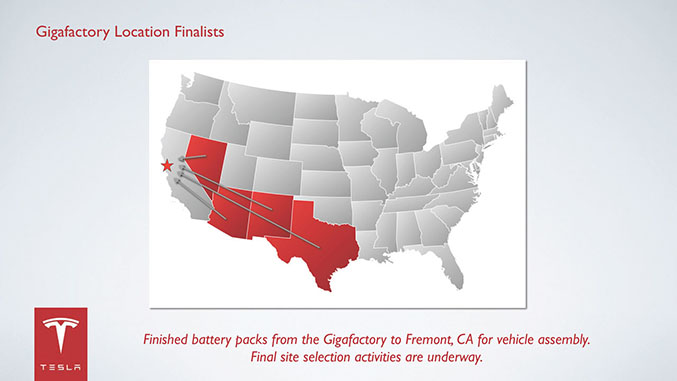While the two companies have had a working relationship for many years now, this most recent development sees the partnership between Panasonic and Tesla expand to an entirely new level, one which could yield "
perhaps hundreds" of factories world wide designed to produce the cylindrical lithium-ion cells used in Tesla automobiles.
While the specifics of the agreement have not been released for public consumption, the basic premise is that Tesla will operate and maintain the Gigafactory while Panasonic will supply the machinery and tooling needed to produce those batteries.
The exact location of the Gigafactory build site still remains a mystery, but Tesla has promised to make an announcement about that
later this year. Completed batteries will be shipped from the Gigafactory out to Tesla’s factory in Fremont, California, where the vehicles themselves are assembled.
The Gigafactory is expected to yield enough batteries for 500,000 EVs per year, which should certainly help to expand Tesla’s market reach and ability to create different types of vehicles. Check out the press release below for additional details on the Gigafactory partnership.
Panasonic and Tesla Sign Agreement for the Gigafactory
Thursday, July 31, 2014
OSAKA, Japan / PALO ALTO, USA, July 31, 2014 – Panasonic Corporation and Tesla Motors, Inc. have signed an agreement that lays out their cooperation on the construction of a large-scale battery manufacturing plant in the United States, known as the Gigafactory.
According to the agreement, Tesla will prepare, provide and manage the land, buildings and utilities. Panasonic will manufacture and supply cylindrical lithium-ion cells and invest in the associated equipment, machinery, and other manufacturing tools based on their mutual approval. A network of supplier partners is planned to produce the required precursor materials. Tesla will take the cells and other components to assemble battery modules and packs. To meet the projected demand for cells, Tesla will continue to purchase battery cells produced in Panasonic’s factories in Japan. Tesla and Panasonic will continue to discuss the details of implementation including sales, operations and investment.
The Gigafactory is being created to enable a continuous reduction in the cost of long range battery packs in parallel with manufacturing at the volumes required to enable Tesla to meet its goal of advancing mass market electric vehicles. The Gigafactory will be managed by Tesla with Panasonic joining as the principle partner responsible for lithium-ion battery cells and occupying approximately half of the planned manufacturing space; key suppliers combined with Tesla’s module and pack assembly will comprise the other half of this fully integrated industrial complex.
JB Straubel, Chief Technical Officer and Co-founder of Tesla Motors said: "the Gigafactory represents a fundamental change in the way large scale battery production can be realized. Not only does the Gigafactory enable capacity needed for the Model 3 but it sets the path for a dramatic reduction in the cost of energy storage across a broad range of applications."
Yoshihiko Yamada, Executive Vice President of Panasonic, added, "We have already engaged in various collaborative projects with Tesla toward the popularization of electric vehicles. Panasonic’s lithium-ion battery cells combine the required features for electric vehicles such as high capacity, durability and cost performance. And I believe that once we are able to manufacture lithium-ion battery cells at the Gigafactory, we will be able to accelerate the expansion of the electric vehicle market."
Cost reductions will be achieved through optimized manufacturing processes driven by economies of scale previously unobtainable in battery cell and pack production. Further price reductions are achieved by manufacturing cells that have been optimized for electric vehicle design, both in size and function, by co-locating suppliers on-site to eliminate packaging, transportation & duty costs and inventory carrying costs, and by manufacturing at a location with lower utility and operating expenses.
The Gigafactory will produce cells, modules and packs for Tesla’s electric vehicles and for the stationary storage market. The Gigafactory is planned to produce 35GWh of cells and 50GWh of packs per year by 2020. Tesla projects that the Gigafactory will employ about 6,500 people by 2020.
Panasonic
http://panasonic.net/
Tesla Motors
http://www.teslamotors.com/blog-and-press-releases






